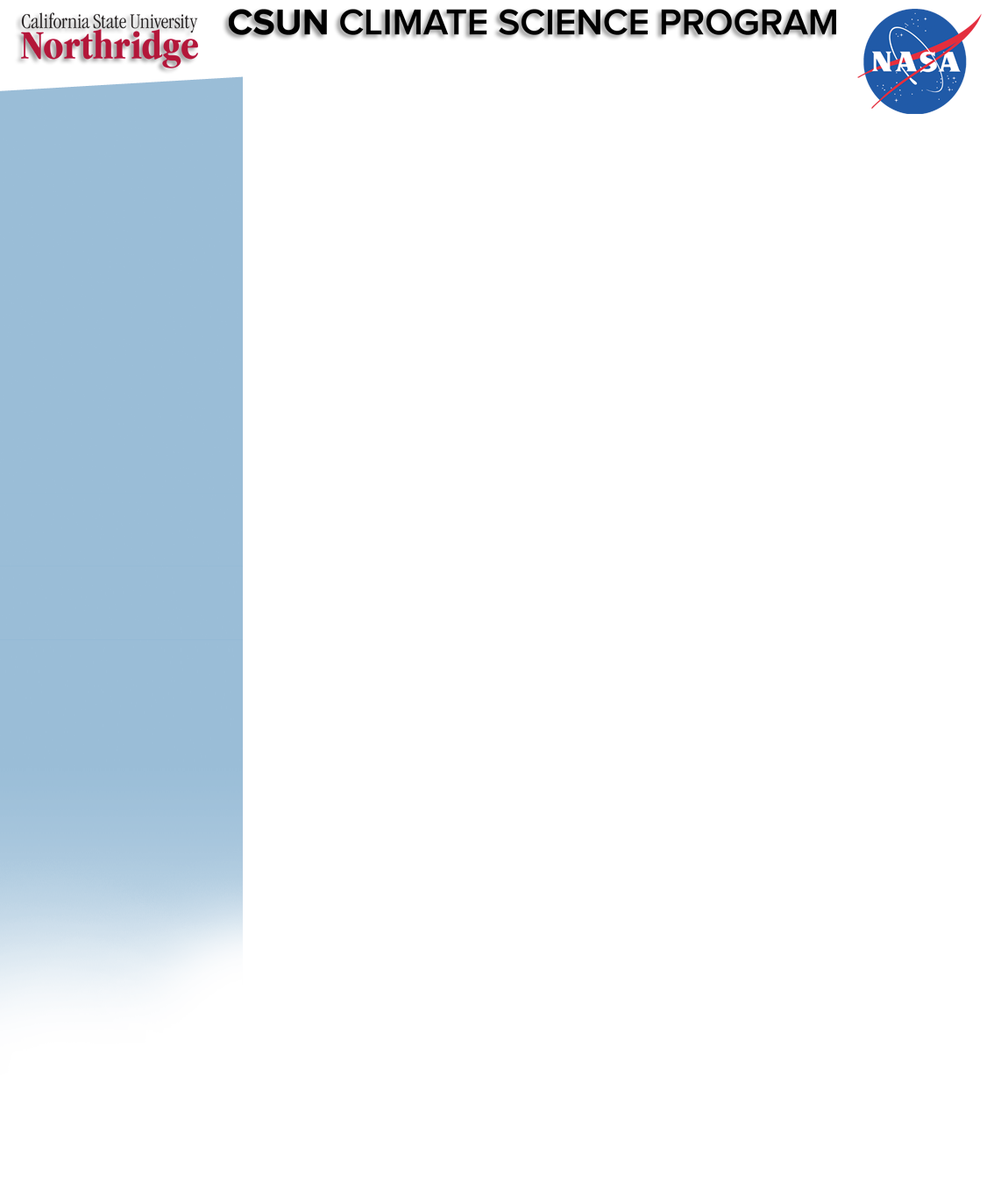Math 483 is a course regularly offered by the CSUN math department in mathematical modeling with varying themes and topics. For the Spring 2013 semester, this course will be co-taught by Cristina Cadavid (Physics & Astronomy dept) and David Klein (Mathematics dept) and will introduce students to global climate modeling. Climate science is a rapidly expanding, interdisciplinary field, with increasing participlation by applied mathematicians.
The focus of the course will be on atmospheric dynamics. Fundamental equations governing atmospheric motion will be derived, analyzed, and used to model various scenarios. The first major topic will be the study of the Lorenz dynamical system. The Lorenz equations constitute a greatly simplified model of atmospheric dynamics, but still exhibit chaotic behavior and illustrate a general relationship between weather and climate. Students will be exposed to the theoretical foundations and be given programming experience with this dynamical system.
Following that, we will derive a dynamical model of land and sea breeze that takes into account effects of lattitude-dependent coroilis forces. The third project will be to model a two dimensional "aqua-planet", i.e., a planet with oceans but no land. The final topic will be full scale global climate models based on eduational software, EdGCM (Eduational Global Climate Model). This software will be provided in the computer lab for the course, but can also be purchased by students.
|
| Class Meetings |
Mondays & Wednesdays, 11:00 to 12:15 p.m., Chaparral Hall 5117
For computer lab meetings: Live Oak 1322 and Citrus Hall 3320 |
| Prerequisites |
Math 340 & 351, or Permission of the Instructors |
Grading |
There will be two midterm exams, each worth 20%, and a final exam worth 30% of the grade. Homework and projects will constitute 30% of the grade. Plus grades (+) and minus grades (–) will be assigned for this course. The date of the midterms will be announced in class. 5 bonus points may be earned for each Climate Seminar presentation attended.
Final Exam: Wednesday, May 15, 2013, 10:15 to 12:15 p.m.
|
| Textbook & Software |
An Introduction to Atmospheric Physics, Second Edition (2010) by David G. Andrews. This will serve primarily as a reference for the lectures. Matlab, the software EdGCM, and other packages will be provided in the computer lab for the course.
|
Instructor Information |
David Klein
Santa Susana Hall, Room 127
Phone: (818) 677-7792
email: david.klein@csun.edu,
web page: www.csun.edu/~vcmth00m
Office Hours: MW 10:30 to 11:30 & by Appointment
Cristina Cadavid
Eucalyptus Hall, Room 2105
Phone: (818) 677- 2171
email: ana.cadavid@csun.edu
Office Hours: 12:15 to 1:15, TTh & by Appointment |
Powerpoints and Other Resources from Lectures |
Understanding Gobal Warming (pdf)
Convection and Lorenz Model powerpoint (pptx)
Derivation of the Lorenz Model (pdf)
Prof. Fovell's March 6 powerpoint (ppt)
On the Linear Theory of Land and Sea Breeze, Richard Rotunno, 1983
Sea-breeze 1 powerpoint Dr. Robert Fovell (pptx)
Sea-breeze 2 powerpoint Dr. Robert Fovell (pptx)
Sea-breeze 3 powerpoint from April 17 class meeting, Dr. Robert Fovell (pptx)
EdGCM workbook (pdf)
Prof. Fovell: Global General Circulation and EdGCM vs Reanalysis April 29 (ppt)
|
Computer Resources |
Introduction to Matlab
Solving ODEs in Matlab
Using DTDM & Grads |
Additional References |
Elementary Climate Physics, by F.W. Taylor
Fundamentals of Atmospheric Physics, by M.L. Salby
An Introduction to Dynamic Meteorology, by James Holton
|
General Resources |
CSUN Climate Science Program: www.csun.edu/climate
Mathematics of Planet Earth, 2013
Intergovernmental Panel on Climate Change
Azimuth, a blog hosted by Prof. John Baez at UC Riverside that includes presentations of climate science topics
Real Climate
The Discovery of Global Warming, by Spencer Weart, director of the Center for History of Physics at the American Institute of Physics. http://www.aip.org/history/climate/index.htm
Laboratory Demonstrations of Planetary-Style Fluid Dynamics, from Spin-Lab at UCLA
Perpetual Ocean: NASA simulation of worldwide ocean currents
Review of Vector Calculus: Chapters 2 and 3 of this CSUN masters thesis, by Rena Petrollo |
Exams and Homework Assignments |
Assignment 1: download Assignment 1 pdf file. Due Wed, Feb. 6
Assignment 2: download Assignment 2 pdf file. Due Mon, Feb. 18
Assignment 3: download Assignment 3 pdf file. Due Wed, Feb. 27
Assignment 4: download Assignment 4 pdf file. Due Mon, March 4
Assignment 5: download Assignment 5 pdf file. Due Wed, March 13
Assignment 6: download Assignment 6 pdf file. Due Wed, March 13
Solutions to Assignment 6
Exam 1: March 18
Assignment 7: download Assignment 7 pdf file. Due Mon, March 25
Solutions to Assignment 7
Assignment 8: Read Chapters 1-3 of Prof. Fovell's AOS 180 notes
Assignment 9: Watch the video, Laboratory Demonstrations of Planetary-Style Fluid Dynamics, before the April 3 class meeting. Solve Problem 4.4 on pg 115 of Andrews (reference text). Due Mon, April 15
Assignment 10: download Assignment 10 pdf file. Due Mon, April 15
Solutions to Assignment 10 to Assignment 10
Assignment 11: Read April 14 notes on the sea-breeze and click download assignment 11 pdf file. Due April 22. Solutions to Assignment 11
Assignment 12: Read EdGCM workbook. Scroll down to: "EdGCM Exercise: Modern Control Runs and Global Warming" at the end of the booklet. Follow the step-by-step instructions, and run the scenarios indicated. Produce on your own and turn in the same graphical output described in that section (but you can use different colors or scales). Note: Video tutorials and instruction manuals are available here: EdGCM documentation. Due May 1.
Instead of an Exam 2, you will be asked to give (with a partner) a 15 minute powerpoint presentation (to be discussed further in class)
|
Climate Fellowship Opportunities |
CSUN Climate Science Program's JPL Summer Fellowships |
| |
|
Document Reader
|

